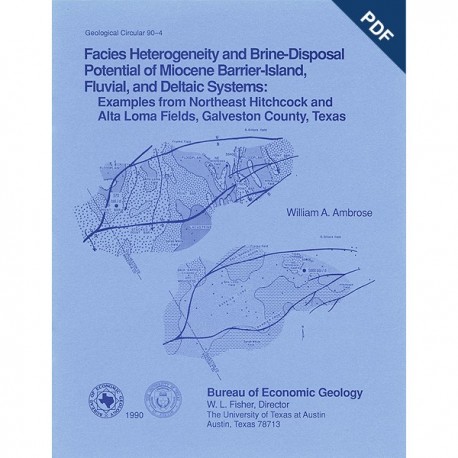Geological Circulars
-
Books & Reports
- Reports of Investigations
- Guidebooks
- Udden Series
- Geological Circulars
- Down To Earth
- Atlases of Major Oil and Gas Reservoirs
- Texas Memorial Museum Publications
- Environmental Geologic Atlas of the Texas Coastal Zone
- Mineral Resource Circulars
- Other Reports
- Seminars and Workshops
- Handbooks
- Submerged Lands of Texas
- Symposia
- Annual Reports
- Open File Reports
-
Maps & Cross Sections
- Thematic Maps
- Miscellaneous Maps, Charts & Sections
- Geologic Atlas of Texas
- STATEMAP Project Maps
- Geologic Quadrangle Maps
- Cross Sections
- Highway Geology Map
- Energy and Mineral Resource Maps
- Shoreline Change and Other Posters
- Wilcox Group, East Texas, Geological / Hydrological Folios
- Bouguer Gravity Atlas of Texas
- River Basin Regional Studies
- Featured Maps
- Posters
- Teachers & the Public
-
Geological Society Publications
- Gulf Coast Association of Geological Societies
- Alabama Geological Society
- Austin Geological Society
- Corpus Christi Geological Society
- Houston Geological Society
- Lafayette Geological Society
- Mississippi Geological Society
- New Orleans Geological Society
- South Texas Geological Society
- GCS SEPM Publications
- Historic BEG & UT Series
Facies Heterogeneity and Brine-Disposal Potential of Miocene...Systems: ...Digital Download
GC9004D
For a print version: GC9004.
GC9004D. Facies Heterogeneity and Brine-Disposal Potential of Miocene Barrier-Island Fluvial and Deltaic Systems: Examples from Northeast Hitchcock and Alta Loma Fields, Galveston County, Texas, by W. A. Ambrose. 35 figs,. 24 figs., 1 table, 1 appendix, 1990. ISSN: 2475-3637. doi.org/10.23867/gc9004D. Downloadable PDF.
To purchase this publication in book format, please order GC9004.
ABSTRACT
To recover gas remaining in solution, large volumes of brine must be produced from watered-out gas reservoirs in the Gulf Coast. Secondary gas recovery in a geopressured upper Frio (Oligocene) reservoir in Northeast Hitchcock and Alta Loma fields in Galveston County, Texas, requires the disposal of approximately 20,000 barrels of brine per day (bblld) into several disposal wells. Calculations of porosity, permeability, and sand thickness indicate that lower and middle Miocene barrier-island sands in Northeast Hitchcock and Alta Loma fields may contain reservoir volumes sufficient for brine disposal at rates of more than 5,000 bbl per well per day for 10 yr or more. These homogeneous, laterally continuous barrier-island sands have permeabilities in excess of 2,000 md. Many individual sands are 40 to 110 ft (12 to 33.5 m) thick and contain pore volumes of 2 to 8 billion barrels (Bbbl) in the 40-mi2 fault block containing Northeast Hitchcock field. Brine-disposal wells can be drilled throughout the field, each well intersecting the homogeneous barrier-core facies in several of these barrier-island sands. For example, disposal wells in Northeast Hitchcock field could be used for injecting brines into the thickest parts of three barrier-island sands, for an injection potential totaling more than 15,000 bbl/d. In contrast, upper Miocene fluvial and deltaic sands in Northeast Hitchcock and Alta Loma fields have less potential for brine disposal. Although individual sand bodies in these systems may locally be more than 100 ft (30 m) thick, they contain a lower net reservoir volume and more heterogeneities than do barrier-island sands. Potential sites for brine disposal into these fluvial and deltaic sands in Northeast Hitchcock and Alta Loma fields are few because of the lenticular geometry of permeable point-bar and distributary-channel sand bodies.
Keywords: Alta Loma field, barrier-island systems, brine disposal, co-production, fluvial and deltaic systems, Galveston County, Miocene, Northeast Hitchcock field, Texas
Citation
Ambrose, W. A., 1990, Facies heterogeneity and brine-disposal potential of Miocene barrier-island, fluvial, and deltaic systems: examples from Northeast Hitchcock and Alta Loma fields, Galveston County, Texas: The University of Texas at Austin, Bureau of Economic Geology Geological Circular 90-4, 35 p. doi.org/10.23867/gc9004D.


